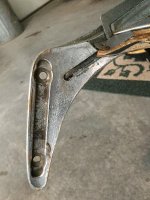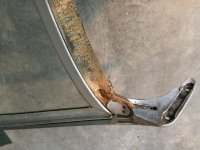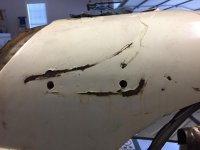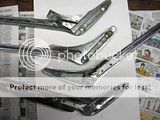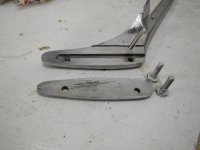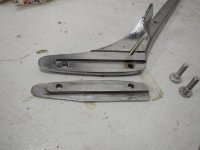kstanley44
Member
Offline
Hi all,
Some may remember I started a frame off restoration of a 62 TR3b (TSF 98) back in March. Actually I have been accused of a destruction rather than a restoration since all I have done so far is take it mostly apart!! But it is time to start the restoration process, and hopefully have some progress to share and of course have a ton of questions to ask.
First question: When taking off the windshield I did not have any guide plates under the stanchions. The stanchions were in direct contact with the scuttle. I understand there have been 4 or so different stanchions. Mine are definitely not the dzus type. But I do have a groove on the back side of the stanchion.
Should there be a guide plate behind the stanchion?
If so what purpose does it have since it would still be only attached by the two chrome slot head bolts that attach the stanchion to the scuttle?
Would a guide plate provide some gap to prevent direct stanchion-scuttle contact, and hence direct contact with paint?
If I should needs guide plates where might I find some?
Hopefully the pictures help some. Thanks for your help,
Kerry
Some may remember I started a frame off restoration of a 62 TR3b (TSF 98) back in March. Actually I have been accused of a destruction rather than a restoration since all I have done so far is take it mostly apart!! But it is time to start the restoration process, and hopefully have some progress to share and of course have a ton of questions to ask.
First question: When taking off the windshield I did not have any guide plates under the stanchions. The stanchions were in direct contact with the scuttle. I understand there have been 4 or so different stanchions. Mine are definitely not the dzus type. But I do have a groove on the back side of the stanchion.
Should there be a guide plate behind the stanchion?
If so what purpose does it have since it would still be only attached by the two chrome slot head bolts that attach the stanchion to the scuttle?
Would a guide plate provide some gap to prevent direct stanchion-scuttle contact, and hence direct contact with paint?
If I should needs guide plates where might I find some?
Hopefully the pictures help some. Thanks for your help,
Kerry

 Hi Guest!
Hi Guest!

 smilie in place of the real @
smilie in place of the real @
 Pretty Please - add it to our Events forum(s) and add to the calendar! >>
Pretty Please - add it to our Events forum(s) and add to the calendar! >> 
